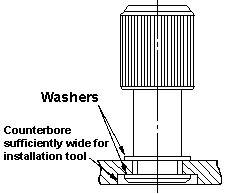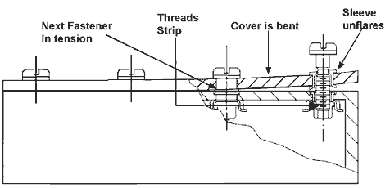Troubleshooting Installations
Misalignment:
In situations where more than one captive screw is used to secure a panel, misalignment could occur when the screw does not line up exactly with its mating hole. This is particularly common if the top and bottom panels are produced by different manufacturers. To eliminate this problem, a “radial float” may be built into the captive fastener assembly. In the case of screws, an oversized hole is drilled and washers are placed on each side of the panel. (See Figure 1.) The maximum available total float in a standard installation is 0.060 in. Misalignment also may be corrected by installing a floating nutplate. HFS offers a floating nutplate that is simply installed by flaring and requires no rivets (rivetless nutplates). The nut element is replaceable, if needed, without removing the entire assembly.

Total Float:
Many definitions can describe the amount of float available in a captive screw or captive nut assembly. Total float refers to the minimum displacement of the shank/nut as it moves diametrically within the hole. In the case of the HFS captive screws, the maximum float is 0.060 in.
Fast Lead Threads:
The advantage of the fast lead threads is in their clamp down speed, which is the speed of the axial travel of the screw per revolution. Fast lead threads considerably reduce the time it takes to remove or secure a panel to its mating part. Because of the increasing angle of the fast lead helix, these threads are prone to loosening under vibration. It is recommended that some method of locking, such as a locking nutplate, be used in conjunction with these threads.
Jack-out Damage:
In situations where several captive screws are used to secure a panel, removal may precipitate damaging jack-out loads. These loads develop when a screw reaches the limit of retention permitted by its sleeve before its threads are completely disengaged from the mating threads of the bottom panel. This can cause damage to threads, the captive screw sleeve and/or the panels themselves.

A simple solution is to specify a captive screw that permits full retraction of the threads within its sleeve. A spring-loaded assembly such as DRB7500 Turn-Loc® fastener series, or an assembly with a controlled thread length will eliminate or significantly reduce jack-out force.
Corrosion:
Corrosion, which is the wearing away or oxidation of a metal, may be caused either by galvanic electrochemical reaction or by direct chemical attack. An example of galvanic corrosion is the oxidation of aluminum plates secured by steel screws in a humid environment. Galvanic attack may be avoided by selecting the same or similar metals in a mating assembly. When dissimilar metals are used, separate them with a dielectric material interface such as insulation or inert compounds. Plating, or other surface coatings, also may be specified.
Vibration:
A captive screw assembly used in an area of vibration may loosen and, in extreme cases, may disengage from its mating part. This can be avoided by using a locking device such as a lock washer or self-locking nutplate.